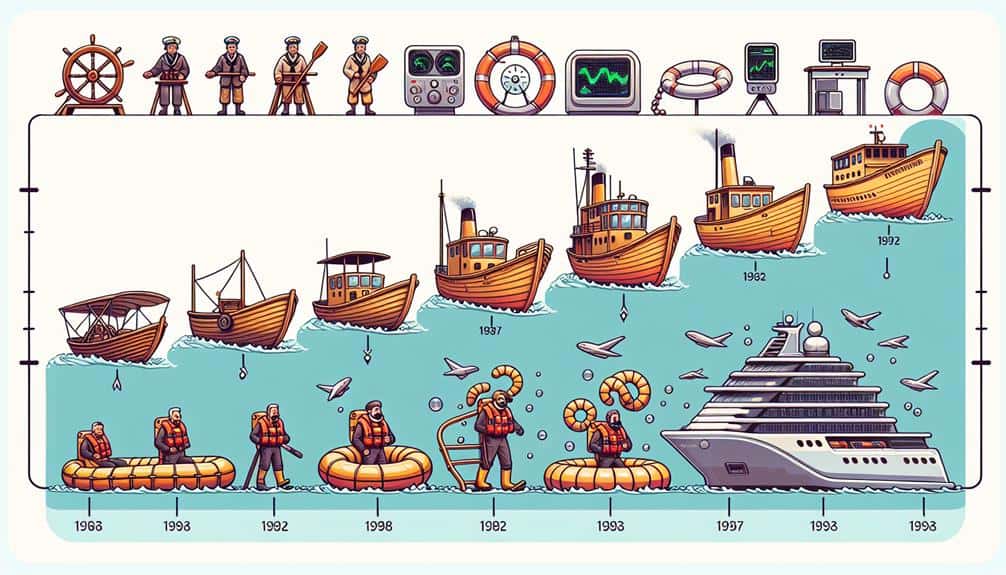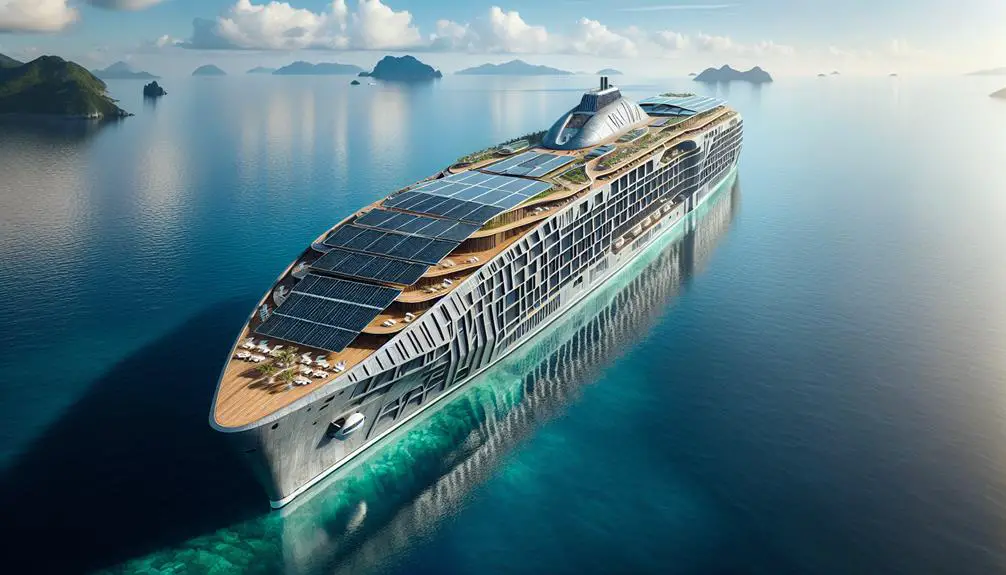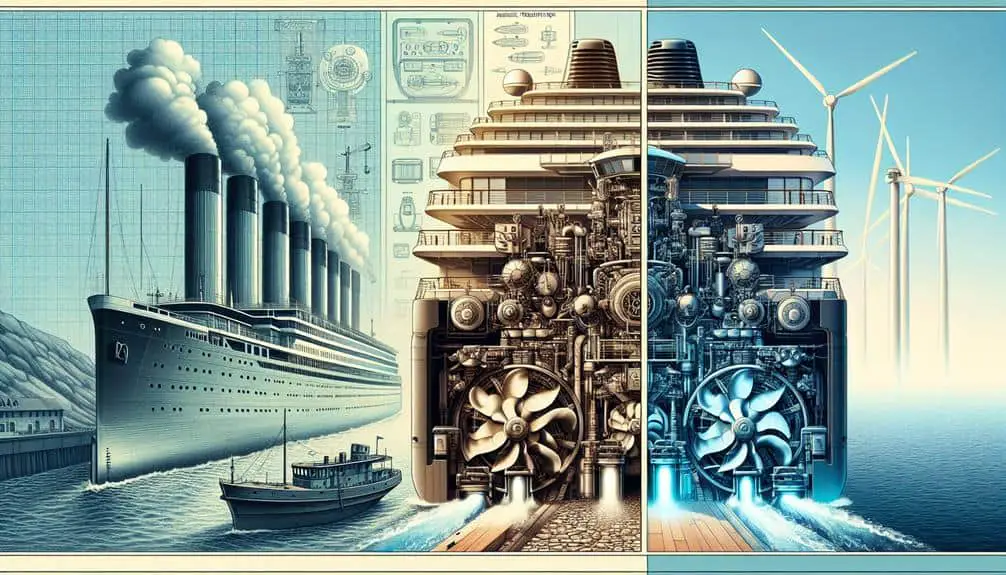Explore the progression of cruise ship safety: from basic lifeboats and fire systems to advanced navigation and emergency response. Enhancements include robust materials, improved communication, and strict protocols. Lifeboat drills guarantee crew readiness and passenger safety. Advanced navigation tools optimize routes and provide real-time information. Emergency protocols continuously refined for swift and effective responses. Integration of cutting-edge technology like emergency beacons and surveillance cameras elevates safety standards. Discover how these advancements have transformed cruise ship safety measures.
Key Points
- Introduction of advanced firefighting systems with automatic detection and suppression capabilities.
- Incorporation of sophisticated emergency response equipment like defibrillators and medical facilities.
- Integration of advanced communication systems for rapid distress signal transmission.
- Implementation of state-of-the-art stability controls to prevent accidents like capsizing.
- Adoption of innovative safety technologies such as drones for monitoring and rescue operations.
Early Safety Measures on Cruise Ships
Early safety measures on cruise ships were basic but essential for the protection of passengers and crew. During the early design and construction of cruise ships, safety features were limited compared to modern standards. Fundamental elements such as lifeboats, life vests, and basic fire suppression systems were incorporated into the ship's layout. However, these measures were often minimal and lacked the complexity seen in contemporary vessels.
Over time, the early design and construction improvements began to focus more on enhancing safety features. Shipbuilders started to prioritize the inclusion of more durable materials, better compartmentalization to prevent flooding, and the implementation of stricter safety regulations. These enhancements aimed to address the vulnerabilities identified in previous incidents and improve the overall safety of passengers and crew onboard.
Despite the initial basic nature of early safety measures on cruise ships, the gradual evolution towards more advanced design and construction improvements laid the foundation for the extensive safety protocols in place on modern cruise ships.
Implementation of Lifeboat Drills
Regularly conducting lifeboat drills is an essential aspect of guaranteeing passenger and crew safety on modern cruise ships. These drills aren't just a formality but a critical practice to assess the readiness of both passengers and crew in the event of an emergency. Practice effectiveness is key in guaranteeing that everyone understands their roles and responsibilities during an evacuation.
Crew preparedness is paramount during lifeboat drills. Crew members must be well-trained in launching lifeboats swiftly and efficiently, as well as in guiding passengers to their designated muster stations. Effective communication and coordination among the crew are crucial to ensure a smooth and organized evacuation process.
The frequency and realism of these drills directly impact their effectiveness. By simulating various emergency scenarios and conducting drills regularly, both crew and passengers can familiarize themselves with emergency procedures and increase their chances of a successful evacuation in a real-life emergency situation. Remember, practice makes perfect when it comes to guaranteeing the safety of all onboard a cruise ship.
To enhance safety measures on modern cruise ships, the development of advanced navigation systems plays a pivotal role in ensuring precise and efficient vessel management. These systems are essential for maintaining the safety of passengers and crew by providing accurate real-time information about the ship's position and surroundings.
- Enhanced Positioning Accuracy: Advanced navigation systems utilize GPS, radar, and other sensors to accurately pinpoint the ship's location, ensuring precise navigation even in challenging conditions.
- Route Optimization Algorithms: These systems incorporate sophisticated algorithms to optimize routes, taking into account factors such as weather conditions, traffic, and potential hazards, thereby enhancing fuel efficiency and safety.
- Integration of Augmented Reality: Modern navigation systems are integrating augmented reality technology to provide visual overlays of real-time data, enhancing situational awareness for the crew and allowing for better decision-making in navigation.
Evolution of Emergency Response Protocols
The evolution of emergency response protocols on modern cruise ships involves the continuous refinement and integration of standardized procedures to guarantee swift and effective reactions to potential safety incidents. One significant aspect of this evolution is the advancement in communication systems. Cruise ships now employ state-of-the-art communication technologies that enable seamless coordination between crew members during emergencies. These systems allow for real-time updates, precise location tracking, and efficient dissemination of critical information, enhancing overall response effectiveness.
Moreover, another vital element driving the evolution of emergency response protocols is enhanced crew training. Cruise ship crew members undergo rigorous training programs that simulate various emergency scenarios to ensure they're well-prepared to handle any situation that may arise. Training modules cover a wide range of topics, including fire emergencies, medical incidents, and evacuation procedures. By continuously improving crew training protocols, cruise lines can guarantee that their staff remains proficient in executing emergency response plans swiftly and decisively, ultimately enhancing the safety of passengers and crew members onboard.
Integration of State-of-the-Art Safety Technology
Integration of state-of-the-art safety technology on modern cruise ships involves the implementation of advanced systems that enhance emergency response capabilities and overall passenger safety. These advancements are essential in guaranteeing the well-being of everyone on board. Here are three key technologies that play a significant role in enhancing safety measures on cruise ships:
- Emergency Beacons: State-of-the-art emergency beacons are strategically placed throughout the ship, allowing for quick and precise location tracking in case of emergencies. These beacons transmit distress signals to rescue teams, enabling swift responses to any potential crisis situations.
- Surveillance Cameras: Advanced surveillance camera systems are integrated into various areas of the ship to monitor activities and detect any safety hazards. These cameras provide real-time footage to security personnel, enhancing overall situational awareness and enabling rapid responses to incidents.
- Automated Alert Systems: Modern cruise ships are equipped with automated alert systems that can detect anomalies in environmental conditions or onboard systems. These systems trigger alarms and notifications to crew members, enabling proactive measures to be taken to mitigate risks and ensure passenger safety.
Frequently Asked Questions
How Do Cruise Ships Handle Medical Emergencies at Sea?
In handling medical emergencies at sea, cruise ships utilize telemedicine services for remote consultations with shoreside medical experts. If necessary, evacuation procedures are activated swiftly to transfer passengers or crew to onshore medical facilities for advanced care.
What Are the Protocols for Handling a Man Overboard Situation on a Cruise Ship?
In a man overboard situation on a cruise ship, emergency drills are vital. Surveillance cameras help locate the individual quickly. Immediate notification to the bridge initiates rescue procedures. Crew response time and coordination are key to a successful outcome.
How Do Cruise Ships Ensure the Safety of Passengers During Extreme Weather Conditions?
In a storm's fierce grip, cruise ships become fortresses of safety. Advanced weather monitoring systems track storms, guiding captains to avoid danger zones. Emergency evacuations plans are meticulously designed, ensuring passengers' safety in extreme conditions.
What Measures Are in Place to Prevent Fires on Cruise Ships and Ensure Passenger Safety in Case of a Fire?
To prevent fires on cruise ships, fire prevention measures like regular inspections, fire drills, and advanced detection systems are in place. Evacuation procedures include designated muster stations, lifeboats, and crew training to guarantee passenger safety in case of a fire.
How Do Cruise Ships Handle Security Threats and Emergencies Such as Terrorist Attacks or Piracy Incidents?
In handling security threats, cruise ships implement stringent security protocols and emergency response procedures. Counterterrorism measures are in place to deter attacks, and piracy prevention strategies are enforced. These measures guarantee passenger safety and swift action in emergencies.




